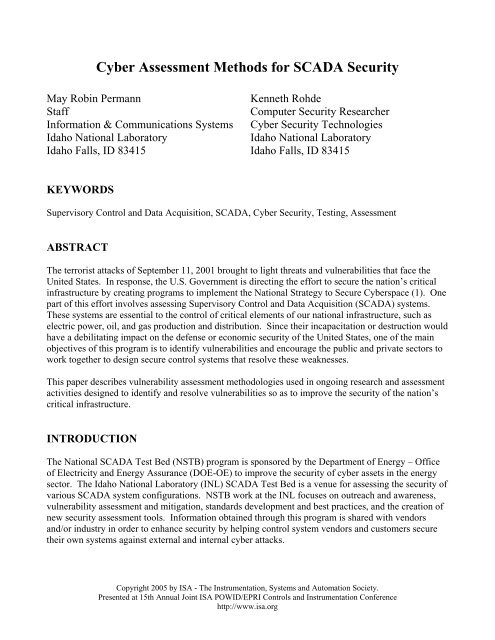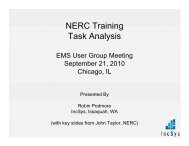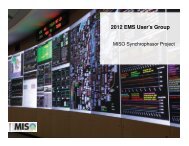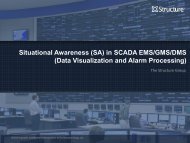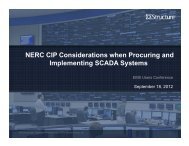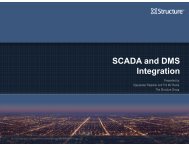Cyber Assessment Methods for SCADA Security - Idaho National ...
Cyber Assessment Methods for SCADA Security - Idaho National ...
Cyber Assessment Methods for SCADA Security - Idaho National ...
You also want an ePaper? Increase the reach of your titles
YUMPU automatically turns print PDFs into web optimized ePapers that Google loves.
<strong>Cyber</strong> <strong>Assessment</strong> <strong>Methods</strong> <strong>for</strong> <strong>SCADA</strong> <strong>Security</strong><br />
May Robin Permann<br />
Kenneth Rohde<br />
Staff<br />
Computer <strong>Security</strong> Researcher<br />
In<strong>for</strong>mation & Communications Systems <strong>Cyber</strong> <strong>Security</strong> Technologies<br />
<strong>Idaho</strong> <strong>National</strong> Laboratory<br />
<strong>Idaho</strong> <strong>National</strong> Laboratory<br />
<strong>Idaho</strong> Falls, ID 83415 <strong>Idaho</strong> Falls, ID 83415<br />
KEYWORDS<br />
Supervisory Control and Data Acquisition, <strong>SCADA</strong>, <strong>Cyber</strong> <strong>Security</strong>, Testing, <strong>Assessment</strong><br />
ABSTRACT<br />
The terrorist attacks of September 11, 2001 brought to light threats and vulnerabilities that face the<br />
United States. In response, the U.S. Government is directing the ef<strong>for</strong>t to secure the nation’s critical<br />
infrastructure by creating programs to implement the <strong>National</strong> Strategy to Secure <strong>Cyber</strong>space (1). One<br />
part of this ef<strong>for</strong>t involves assessing Supervisory Control and Data Acquisition (<strong>SCADA</strong>) systems.<br />
These systems are essential to the control of critical elements of our national infrastructure, such as<br />
electric power, oil, and gas production and distribution. Since their incapacitation or destruction would<br />
have a debilitating impact on the defense or economic security of the United States, one of the main<br />
objectives of this program is to identify vulnerabilities and encourage the public and private sectors to<br />
work together to design secure control systems that resolve these weaknesses.<br />
This paper describes vulnerability assessment methodologies used in ongoing research and assessment<br />
activities designed to identify and resolve vulnerabilities so as to improve the security of the nation’s<br />
critical infrastructure.<br />
INTRODUCTION<br />
The <strong>National</strong> <strong>SCADA</strong> Test Bed (NSTB) program is sponsored by the Department of Energy – Office<br />
of Electricity and Energy Assurance (DOE-OE) to improve the security of cyber assets in the energy<br />
sector. The <strong>Idaho</strong> <strong>National</strong> Laboratory (INL) <strong>SCADA</strong> Test Bed is a venue <strong>for</strong> assessing the security of<br />
various <strong>SCADA</strong> system configurations. NSTB work at the INL focuses on outreach and awareness,<br />
vulnerability assessment and mitigation, standards development and best practices, and the creation of<br />
new security assessment tools. In<strong>for</strong>mation obtained through this program is shared with vendors<br />
and/or industry in order to enhance security by helping control system vendors and customers secure<br />
their own systems against external and internal cyber attacks.<br />
Copyright 2005 by ISA - The Instrumentation, Systems and Automation Society.<br />
Presented at 15th Annual Joint ISA POWID/EPRI Controls and Instrumentation Conference<br />
http://www.isa.org
Ongoing research and assessment activities have revealed an effective methodology <strong>for</strong> identifying<br />
vulnerabilities and developing assessment methods to secure <strong>SCADA</strong> systems. This assessment<br />
methodology, which resulted from lessons learned when testing vendor systems, is presented in this<br />
paper <strong>for</strong> the purpose of helping vendors, utilities, and others assess and enhance security measures on<br />
their own <strong>SCADA</strong> systems.<br />
ASSESSMENT METHODOLOGY<br />
The steps involved in this assessment methodology are: developing an assessment plan, configuring<br />
the test environment, assessing the system, reporting requirements, and using assessment metrics <strong>for</strong><br />
scoring. The purpose of each step and suggestions <strong>for</strong> implementing them are discussed in the<br />
following sections.<br />
ASSESSMENT PLAN DEVELOPMENT<br />
<strong>Security</strong> assessments should be bounded by a detailed assessment plan that specifies a schedule and<br />
budget, targets and goals, expected deliverables, hardware and resource requirements, rules of<br />
engagement, and a recovery procedure. The team assigned to per<strong>for</strong>m the assessment should be<br />
involved in the development of the assessment plan.<br />
Assessing the vulnerability of an in<strong>for</strong>mation system can be a never-ending task as one digs deeper and<br />
deeper into the system, exposing vulnerabilities and finding new exploits. Specifying the time and<br />
resources to be spent on any one task keeps the level of ef<strong>for</strong>t in check. It is important, there<strong>for</strong>e, that<br />
the assessment plan specify targets of evaluation (TOEs) to be tested. The Common Criteria <strong>for</strong><br />
In<strong>for</strong>mation Technology (IT) <strong>Security</strong> Evaluation (2) defines a TOE as an IT product or system with IT<br />
security functions. This includes operating systems, computer networks, distributed systems, and<br />
applications. For this application, a TOE is typically a subset of the <strong>SCADA</strong> system.<br />
As an example, a TOE <strong>for</strong> a <strong>SCADA</strong> system might be the alarms and commands to and from the field<br />
components. One method of attack to change alarms and commands would be to analyze the network<br />
traffic to and from the Human-Machine Interface and develop a man-in-the-middle (MITM) style of<br />
manipulation. In an MITM attack, an attacker is able to read, insert, and modify messages between<br />
two parties without either party knowing that the link between them has been compromised. A<br />
functional description of the alarms and commands and their importance as well as ways of<br />
accomplishing an MITM attack on the system being tested could be included in the test plan to help<br />
testers focus the attacks. This assumes that an insider or an accomplished hacker has already<br />
penetrated the perimeter and gained access to the <strong>SCADA</strong> network. A flow chart, such as the one in<br />
Fig.1, could also be included in the assessment plan to better illustrate this process.<br />
Copyright 2005 by ISA - The Instrumentation, Systems and Automation Society.<br />
Presented at 15th Annual Joint ISA POWID/EPRI Controls and Instrumentation Conference<br />
http://www.isa.org
Host Selection<br />
Unauthorized Access or<br />
Insider Threat<br />
Host<br />
Attack<br />
Type<br />
Network<br />
Man-In-The-Middle Attack<br />
and Network Monitoring<br />
Issue Operator<br />
Alarms or<br />
Commands<br />
Monitor Packets<br />
Filter Packets of Interest<br />
Filter<br />
No<br />
Encrypted<br />
Protocol<br />
Intercept Packet<br />
Modify Packet Contents<br />
Forward Packet<br />
Modify<br />
Yes<br />
Denial of Service<br />
(Block Communication)<br />
End<br />
Fig. 1: Modifying Alarms and Commands<br />
Based upon priorities and resources, an allocated testing period would define the level of ef<strong>for</strong>t to give<br />
this task. The test plan would help the testers get started by suggesting methods of attack based on the<br />
combined knowledge of the cyber and <strong>SCADA</strong> team members. Data requirements describe the<br />
in<strong>for</strong>mation that must be gathered be<strong>for</strong>e attempting the TOE, and in many ways define the difficulty<br />
of the attack and characterize the attacker. For this example, a detailed composition of the message<br />
<strong>for</strong>mat and the complete process <strong>for</strong> changing both an alarm and a command would be valuable<br />
in<strong>for</strong>mation <strong>for</strong> achieving this TOE. Finally, a definition of a successful attack lets the test team know<br />
when they have accomplished the task.<br />
Generally, TOEs should be prioritized in the assessment plan based on how critical they are to the<br />
operation of the whole system, and a corresponding level of ef<strong>for</strong>t <strong>for</strong> testing should be defined <strong>for</strong><br />
each one. Prioritizing the list of TOEs allows the assessment team to specify which ones must be<br />
evaluated, with the flexibility of having additional TOEs to assess should time remain. Flexibility in<br />
the assessment process, however, is extremely important, and schedule or resource adjustments should<br />
be allowed to account <strong>for</strong> unexpected findings during testing.<br />
Along with accomplishing the TOEs, the team may also be expected to produce other deliverables such<br />
as intermediate and final reports. These expectations should be identified in the assessment plan.<br />
Copyright 2005 by ISA - The Instrumentation, Systems and Automation Society.<br />
Presented at 15th Annual Joint ISA POWID/EPRI Controls and Instrumentation Conference<br />
http://www.isa.org
The rules of engagement define the knowledge, funding, and timeframe of the attacker(s) as well as<br />
their skills and capabilities. Defining the attacker aids in the development of the types of attacks and<br />
where they are based. Possibilities include a nation state, a well-funded terrorist, a hacker who has<br />
penetrated the firewall or otherwise gained access to the <strong>SCADA</strong> network, and/or an insider.<br />
A recovery plan should be delineated in case vulnerability testing corrupts the system. This could be<br />
implemented with tape backups, ghosting, or mirrored disks that are removed be<strong>for</strong>e testing.<br />
A well-defined assessment plan provides detailed direction to the team, eliminating confusion and<br />
wasted time. The time allocated <strong>for</strong> testing is well utilized and productive.<br />
TESTING ENVIRONMENT CONFIGURATION<br />
The ideal environment to assess the <strong>SCADA</strong> is a safe (non-production) configuration. However, it is<br />
also desirable to have all connecting components and functionality available in order to confidently<br />
assess full system interoperability. This includes everything from the Inter-Control Center<br />
Communication Protocol (ICCP) link to the Remote Terminal Unit (RTU) connectivity. ICCP is the<br />
international standard, International Electrotechnical Commission (IEC) Std 870-6 Telecontrol<br />
Application Service Element Two (TASE.2), <strong>for</strong> real-time data communication between control<br />
centers. An RTU is used in <strong>SCADA</strong> systems at a remote location to collect code and transmit data<br />
back to the control station, as well as receive and implement commands from the control center.<br />
Ideally, these components are configured with actual signals <strong>for</strong> the assessment, although emulators<br />
and simulators may be necessary.<br />
The ability to establish a typical <strong>SCADA</strong> installation allows the assessment team to more accurately<br />
test and make recommendations on the configuration and deployment of a production system.<br />
Understanding the system configuration is key when deciding where the biggest risks in the system<br />
may reside and, there<strong>for</strong>e, which TOEs are top priority. Mirroring the connections to external systems<br />
is vital when replicating this configuration. The assessment team must know where and how a<br />
<strong>SCADA</strong> system element typically connects to such things as the Internet, ICCP servers, and RTUs.<br />
Any of these elements being accessed from outside the <strong>SCADA</strong> network, such as the Historian<br />
database, should be tested based on its position in the network. Firewall and intrusion detection system<br />
(IDS) configurations should be duplicated in order to test the effectiveness of the perimeter security<br />
they provide. IDSs can be tested to determine if they detect intrusions into the <strong>SCADA</strong> system. In<br />
general, the firewall(s) en<strong>for</strong>ce the security policy <strong>for</strong> the <strong>SCADA</strong> system and the IDS is a auditor to<br />
ensure that the rules are en<strong>for</strong>ced. Accepted and normal operating procedures need to be known in<br />
order to assess the likelihood of an attack being successful. The goal of many attacks is to alter<br />
in<strong>for</strong>mation and/or commands coming into or going out of the <strong>SCADA</strong> system. A completely<br />
functional system, or reasonable representation, provides a realistic assessment environment since<br />
complete determination of the results or consequences of an attack is dependant upon all of the<br />
interconnected functionalities within the system. For example, assessing a system without a redundant<br />
backup system with automatic failover doesn’t show how a system which is usually implemented with<br />
redundancy responds to an attack.<br />
Copyright 2005 by ISA - The Instrumentation, Systems and Automation Society.<br />
Presented at 15th Annual Joint ISA POWID/EPRI Controls and Instrumentation Conference<br />
http://www.isa.org
There are several features that are desirable when assessing a <strong>SCADA</strong> system. A working ICCP link<br />
<strong>for</strong> I/O testing and as many representative RTU protocol connections (i.e., Transmission Control<br />
Protocol and the Internet Protocol [TCP/IP] or protocols that are supported and used in the field) allow<br />
<strong>for</strong> testing of the control specific communication protocols. If applicable, a corporate network<br />
separated by a firewall from <strong>SCADA</strong> should be simulated. If a historian database is typically placed in<br />
the corporate network, that configuration should be implemented in the target system. Firewalls and<br />
intrusion detection systems that are either recommended by the vendor, representative of the typical<br />
installed system, or recommended by cyber security professionals offer a configuration to be validated<br />
so that a recommendation can be given <strong>for</strong> all installations. Firewall configuration and other security<br />
features must be tested by the vendor to validate that they do not affect the operability of the <strong>SCADA</strong><br />
system.<br />
VULNERABILITY ASSESSMENTS<br />
Penetration testing must be conducted from a machine that is not part of the <strong>SCADA</strong> system unless<br />
otherwise defined in the assessment plan (i.e., an insider threat). This replicates a typical attack<br />
scenario where the attacker must penetrate the system from a remote computer. Placement of the<br />
attack computer depends on what is being tested and where the attack scenario originates.<br />
Sophisticated attacks are often system specific and tailored to the target computer’s architecture.<br />
There<strong>for</strong>e, the attacker needs a similar computer to create and test malicious code. For example, if<br />
64-bit processors are used in the target <strong>SCADA</strong> system, the assessment team may need equivalent<br />
hardware and software <strong>for</strong> developing exploits specific to that architecture. Although in a test<br />
environment there is direct access to the target system, its configuration should not be altered. A<br />
separate machine is needed to install required software such as compilers, debuggers, and other tools.<br />
It may not be feasible to obtain test computers <strong>for</strong> each represented hardware or software configuration<br />
on the <strong>SCADA</strong> system, but doing so would improve the assessment time and results.<br />
Dedicated assessment equipment is also necessary <strong>for</strong> the assessment to be conducted without<br />
interruption. An attack machine with all the tools needed to per<strong>for</strong>m the vulnerability assessment<br />
should be available <strong>for</strong> this work. In addition, a reliable Internet connection <strong>for</strong> research in the test area<br />
makes work more efficient.<br />
It is also important to return the system to its original state be<strong>for</strong>e each new test. This could be<br />
implemented with the same process as the backup plan. This insures that all effects are from the<br />
current exploit.<br />
The following steps proved to be a useful method of assessing a <strong>SCADA</strong> system. These may vary<br />
depending on the assessment plan TOEs and rules of engagement.<br />
1. Per<strong>for</strong>m reconnaissance to gather in<strong>for</strong>mation on the target system if not previously defined in the<br />
assessment plan<br />
2. Scan the <strong>SCADA</strong> network <strong>for</strong> open ports and vulnerabilities<br />
Copyright 2005 by ISA - The Instrumentation, Systems and Automation Society.<br />
Presented at 15th Annual Joint ISA POWID/EPRI Controls and Instrumentation Conference<br />
http://www.isa.org
3. Achieve the TOEs defined in the assessment plan.<br />
The following resources and advice are valuable in the assessment process:<br />
• Prioritized vulnerabilities to assess based on the probability of obtaining the target and its<br />
significance<br />
• Dedicated semi-private work area<br />
• Broadband (reliable) internet access <strong>for</strong> research<br />
• Vendor help and support<br />
• Backing up the target (<strong>SCADA</strong>) system<br />
• Rebooting the system after every attack to ensure all of the effects are presented; some effects may<br />
not be apparent until the system has been rebooted.<br />
ASSESSMENT TOOLS<br />
Below is a list of the open source and commercial tools useful <strong>for</strong> assessing <strong>SCADA</strong> systems. Specific<br />
tools are listed because they are commonly available and are the best or only option without<br />
developing a tool <strong>for</strong> the specific application.<br />
It is important to note that these scans and exploits are being run in a controlled lab environment. Any<br />
of these used on a production system could cause it to malfunction or stop operating. Legal restrictions<br />
on using scanning tools and exploits across a public network or your own computing systems vary.<br />
There<strong>for</strong>e, check with your company legal personnel and get permission from the appropriate company<br />
authorities be<strong>for</strong>e running any of the following attacks.<br />
NMAP<br />
Nmap is an open source multi-purpose network scanning tool used mainly as a port-mapper. It<br />
identifies open ports on each machine. This in<strong>for</strong>mation is then used to identify the services that are<br />
actually running on each port. This is one part of the in<strong>for</strong>mation-gathering phase of a vulnerability<br />
assessment. The list of open ports on each machine gives a place to start testing <strong>for</strong> open holes into the<br />
<strong>SCADA</strong> system, but further analysis is required to not only verify the Nmap results but to also query<br />
“unknown” ports returned by Nmap. Care should be taken when running this tool on a production<br />
machine as it could cause aberrant behavior. Nmap scans should be per<strong>for</strong>med on a test or backup<br />
system, if available (3).<br />
NESSUS<br />
The Nessus open source remote security scanner per<strong>for</strong>ms nearly 6000 security checks against a target<br />
system, detecting vulnerable services running on the scanned hosts and providing a warning level and<br />
recommended fix <strong>for</strong> each possible vulnerability. Nessus is very flexible and can be configured to<br />
per<strong>for</strong>m only the appropriate tests. The Nessus output can be used as another starting point <strong>for</strong><br />
assessing a system. The Nessus report identifies possible vulnerabilities that the assessment team can<br />
Copyright 2005 by ISA - The Instrumentation, Systems and Automation Society.<br />
Presented at 15th Annual Joint ISA POWID/EPRI Controls and Instrumentation Conference<br />
http://www.isa.org
then try to exploit thereby verifying or disproving the <strong>SCADA</strong> system’s susceptibility to that particular<br />
threat. It is not enough to report all vulnerabilities discovered in a Nessus scan as many of them may<br />
not actually affect the system and/or are false positives reported by Nessus. Conversely, Nessus may<br />
not detect all vulnerabilities; there<strong>for</strong>e, it is only a starting point <strong>for</strong> assessing the system. It does not,<br />
<strong>for</strong> example, check <strong>for</strong> vulnerable installed software that runs locally on a computer (e.g.,<br />
vulnerabilities with versions of Internet Explorer). Other vulnerability scanning tools are used <strong>for</strong> this<br />
task (see STAT Scanner below) (4).<br />
STAT SCANNER<br />
The commercially available STAT Scanner by Harris Corporation is useful in evaluating<br />
Windows-based systems in greater depth. The package provides superior detection of vulnerabilities<br />
on Microsoft operating systems, applications, and components. It has a low rate of false positives,<br />
excellent reporting capabilities, and is relatively inexpensive. For the Microsoft Windows 2003 and<br />
Windows XP operating systems, the software requires access to the local administrator account on the<br />
host and requires the messenger, server, and remote registry services to be enabled.<br />
STAT Scanner provides powerful reporting capabilities and is also available <strong>for</strong> other plat<strong>for</strong>ms (5).<br />
ETHEREAL<br />
Ethereal is a widely used open source network protocol analyzer that allows communications<br />
monitoring between the individual <strong>SCADA</strong> system components. This is useful <strong>for</strong> discovering which<br />
components communicate, if communications are encrypted, and intercepting in<strong>for</strong>mation (including<br />
user names and passwords) being sent in plain text (6).<br />
ETTERCAP<br />
Ettercap is an open source suite <strong>for</strong> MITM attacks on switched networks. It features sniffing of live<br />
connections, content filtering “on the fly,” and other capabilities such as active and passive dissection<br />
of many protocols (even ciphered ones) and password grabbing from specific applications. This<br />
allows a MITM attack to be created <strong>for</strong> viewing communications between the <strong>SCADA</strong> system<br />
components in Ettercap and/or Ethereal, and testing the system against Ettercap’s other attack<br />
capabilities (7).<br />
METASPLOIT<br />
The Metasploit Framework is an advanced open-source plat<strong>for</strong>m <strong>for</strong> developing, testing, and using<br />
exploit code. It is a powerful tool <strong>for</strong> penetration testing, exploit development, and vulnerability<br />
research. Metasploit provides a set of application programming interfaces (APIs) that is used by cyber<br />
testers <strong>for</strong> packaging customer exploit code in a reusable and automated fashion (8).<br />
Copyright 2005 by ISA - The Instrumentation, Systems and Automation Society.<br />
Presented at 15th Annual Joint ISA POWID/EPRI Controls and Instrumentation Conference<br />
http://www.isa.org
DEBUGGERS<br />
Debuggers allow one to evaluate a program during execution or a program’s state at the moment it<br />
crashed. The main functions of this tool are to:<br />
• Execute a program, given any input parameters which affect its behavior<br />
• Allow the user to step through the program instructions, or stop and start the program at any<br />
given points<br />
• Allow the user to examine and change values at stop points or after it crashes.<br />
<strong>SCADA</strong> system software can be analyzed in a similar manner to search <strong>for</strong> unsecured programming<br />
practices that allow an attacker to gain access through a known vulnerability into the system.<br />
Debuggers can also be used to find security holes such as possible buffer or heap overflows, places<br />
where the program crashes, and other code that is not secure. Buffer overflows can be analyzed, <strong>for</strong><br />
example, by testing programs in a debugger with different input parameters. Some examples of<br />
debuggers are GDB, IDA Pro, and those built into compilers such as the Microsoft Visual Studio.<br />
SOFTWARE DEVELOPMENT TOOLS<br />
Software development tools facilitate software development, giving the programmer a user-friendly<br />
interface <strong>for</strong> writing, debugging, and compiling the code. These tools are useful in vulnerability<br />
assessments <strong>for</strong> analyzing code <strong>for</strong> safe programming practices and <strong>for</strong> generating exploit code with<br />
which to test the <strong>SCADA</strong> system. The most common software development environments are the<br />
GNU compiler/debugger packages <strong>for</strong> UNIX- and Linux-based operating systems, and Microsoft’s<br />
Visual C <strong>for</strong> Windows operating systems.<br />
PUBLISHED EXPLOITS<br />
Rather than reinvent the wheel, it is most efficient to use any published exploits <strong>for</strong> the components in<br />
the target system. This is a quick approach <strong>for</strong> verifying vulnerabilities in a system. Many wellknown<br />
exploits have associated exploit code available on the internet that can be downloaded and run<br />
against the system. However, caution should be used when entering sites that house exploit code as<br />
well; visiting such sites presents a danger of attack by the site or by the downloaded code.<br />
IN HOUSE CODE DEVELOPMENT<br />
When no public exploits are available <strong>for</strong> targeted systems, the ability to develop exploits in house is<br />
very valuable because it allows the researchers to not only report discovered vulnerabilities, but<br />
provide working exploits back to the customer. An example of this is the discovery of a vulnerability<br />
in a vendor’s software application. This application is not widely available to the public, yet it still<br />
suffers from some common software vulnerabilities. Simply stating that these vulnerabilities exist is<br />
much less authoritative than providing documents of the vulnerability along with working exploit code.<br />
Copyright 2005 by ISA - The Instrumentation, Systems and Automation Society.<br />
Presented at 15th Annual Joint ISA POWID/EPRI Controls and Instrumentation Conference<br />
http://www.isa.org
In order to develop in-house code <strong>for</strong> security assessments, the assessment team must have access to<br />
personnel with extensive experience in assembly code, debugging, reverse engineering, and computer<br />
hardware. Creating an assessment team with these resources creates a complete and comprehensive set<br />
of skills <strong>for</strong> thorough security testing.<br />
FUZZERS<br />
Fuzzers are an automated way of finding vulnerabilities by feeding the target application with a wide<br />
range of invalid input. Input that causes the application to respond abnormally or crash is then used to<br />
identify vulnerabilities. The fuzzer can look <strong>for</strong> specific kinds of vulnerabilities and can range from<br />
manual mode to fully automated. Vulnerabilities typically identified are application level overflows<br />
and <strong>for</strong>mat string vulnerabilities. They are best suited <strong>for</strong> services using documented protocols,<br />
standard servers, web applications, and protocols with many field combinations (9).<br />
STATIC CODE ANALYSIS<br />
Static code analysis disassembles binary executables, looking <strong>for</strong> vulnerabilities. A disassembler can<br />
be used to translate the executable into a higher level language that is easier <strong>for</strong> the evaluator to<br />
understand. This is a very time consuming process, but provides a very deep analysis of the<br />
application code. This process is best <strong>for</strong> finding protocol level overflows, complex vulnerabilities and<br />
integer vulnerabilities in protocol parsers, unknown protocols, code using unsafe functions, and critical<br />
code sections.<br />
IDA PRO<br />
Interactive Disassembler (IDA) Pro is a Windows or Linux hosted multi-processor disassembler and<br />
debugger. This tool can be used in vulnerability research <strong>for</strong> code analysis and software reverse<br />
engineering. It is one of the most advanced tools <strong>for</strong> hostile code analysis, vulnerability research, and<br />
reverse engineering. This tool allows assessment teams to evaluate software on the <strong>SCADA</strong> system<br />
<strong>for</strong> simple vulnerabilities (10).<br />
SUBJECT MATTER EXPERTS (SMEs)<br />
SMEs are some of the most valuable resources in the vulnerability assessment process. Experts in both<br />
cyber security and the target <strong>SCADA</strong> system are crucial to a thorough security assessment.<br />
Subject matter experts in how the system operates and its most critical functions help guide the<br />
assessment process. Using a <strong>SCADA</strong> system specialist to define how the system works can<br />
substantially reduce the time required <strong>for</strong> an attacker to gather the in<strong>for</strong>mation required to plan the<br />
attack.<br />
Copyright 2005 by ISA - The Instrumentation, Systems and Automation Society.<br />
Presented at 15th Annual Joint ISA POWID/EPRI Controls and Instrumentation Conference<br />
http://www.isa.org
<strong>Cyber</strong> security experts know how to use and develop vulnerability tools, test <strong>for</strong> and verify the<br />
existence of vulnerabilities, and recommend fixes and secure practices. For instance, an expert in<br />
running the STAT Scanner software is a valuable resource because the expert’s opinion can be used to<br />
characterize the risk reduction between system versions and recommend ways to secure the current<br />
version.<br />
BOOKS<br />
In addition to some of the software development tools, books on Windows Administration, Linux<br />
Administration, Scripting, and Command-line References are very helpful in testing <strong>for</strong> vulnerabilities.<br />
<strong>Security</strong> books can provide a process and identify vulnerabilities to test <strong>for</strong> in particular operating<br />
systems and applications. The particular books selected depend on the individual components in the<br />
system under review and the knowledge of the assessment team. Due to the constant evolution of<br />
software and vulnerabilities, reference materials should be kept up to date with the latest hacking<br />
techniques and in<strong>for</strong>mation on the current operating system and application versions being used in the<br />
<strong>SCADA</strong> system. Potential resources <strong>for</strong> vulnerability testing are the “Hacking Exposed” series of<br />
books (11). The in<strong>for</strong>mation in some books can also be found on the Internet, such as the Windows<br />
command line reference (12).<br />
HARDWARE<br />
Often times <strong>SCADA</strong> systems use operating systems and hardware that are not in wide usage. Due to<br />
this fact, it is important that the assessment team have access to some of these less common plat<strong>for</strong>ms<br />
so that they can build their own testing environment <strong>for</strong> use during an assessment. An example might<br />
be an Alpha Server running Tru64 UNIX.<br />
LOGS<br />
System logs should be saved during testing because they can be used to indicate intrusions.<br />
In<strong>for</strong>mation gathered during testing can later be used <strong>for</strong> discovering these attacks on a production<br />
system.<br />
REPORTING<br />
Detailed reporting of all tools used against the <strong>SCADA</strong> system and the associated steps, findings, and<br />
system response is invaluable. This includes archiving the test tools and scripts used. Documenting<br />
this in<strong>for</strong>mation as quickly as possible assures that no in<strong>for</strong>mation is <strong>for</strong>gotten and saves time when<br />
trying to duplicate the attack. This in<strong>for</strong>mation can then be used in the future <strong>for</strong> writing reports and<br />
validating which tests were conducted and whether the system was susceptible to them. Reports also<br />
provide a way to reproduce an attack when confirming that the hole was fixed in the next version of<br />
the software. The goal <strong>for</strong> this process should be to document to the level where someone skilled in<br />
the area could duplicate the results.<br />
Copyright 2005 by ISA - The Instrumentation, Systems and Automation Society.<br />
Presented at 15th Annual Joint ISA POWID/EPRI Controls and Instrumentation Conference<br />
http://www.isa.org
The following reporting guidelines make reporting and future verification straight<strong>for</strong>ward:<br />
• Write detailed weekly reports<br />
• Keep the report writer involved during the assessment, at least at high level, so report writing is<br />
easier and more accurate<br />
• Keep documentation of testing<br />
• Archive testing tools and scripts <strong>for</strong> reproducibility<br />
• Use configuration management<br />
• Reboot and revert to the original configuration between each test.<br />
Proprietary or otherwise sensitive data collected on specific systems must be protected against external<br />
release. Internal controls should include physical isolation during testing, assurance that anyone<br />
obtaining vulnerability in<strong>for</strong>mation acknowledges applicable agreements, and security on computer<br />
systems holding the data. The organization conducting the assessment should have an administrative<br />
security program that clearly defines protection controls and implements security background checks<br />
of all personnel with access to the data.<br />
METRICS AND SCORING<br />
It is important to have a way to quantitatively measure the security of a system to determine its risk<br />
level, measure risk reduction due to security enhancements, and evaluate how it compares to other<br />
systems. Since there is no tool to per<strong>for</strong>m these tasks, the best way to do it is to seek the opinion of<br />
cyber security experts. This is somewhat subjective, however. The Department of Homeland <strong>Security</strong><br />
(DHS) is currently working on a risk-based decision methodology that can be used to calculate risks<br />
associated with potential terrorist acts that utilize control systems (13).<br />
In<strong>for</strong>mation Technology (IT)-based scoring systems do exist. Experience using these tools shows that<br />
it is important to decide on a scoring system be<strong>for</strong>e the assessment is per<strong>for</strong>med. This ensures that the<br />
necessary data can be gathered <strong>for</strong> more meaningful scoring.<br />
SUMMARY<br />
Methodologies <strong>for</strong> per<strong>for</strong>ming vulnerability assessments of <strong>SCADA</strong> systems are being developed<br />
through ongoing research, with the goal of improving the security of the nation’s critical infrastructure.<br />
This experience can be leveraged to refine the assessment process and provide industry with better<br />
options to secure their section of the infrastructure.<br />
Lessons learned in a laboratory environment can be taken advantage of in other environments as well.<br />
Those sites which operate with backup and test systems can per<strong>for</strong>m vulnerability assessments on these<br />
systems. Many hacking tools and resources are available <strong>for</strong> sale or as free downloads off the Internet.<br />
These tools do require some computer skills and there<strong>for</strong>e should only be per<strong>for</strong>med by a qualified<br />
IT/cyber security professional.<br />
Copyright 2005 by ISA - The Instrumentation, Systems and Automation Society.<br />
Presented at 15th Annual Joint ISA POWID/EPRI Controls and Instrumentation Conference<br />
http://www.isa.org
REFERENCES<br />
1. Bush, George, “<strong>National</strong> Strategy to Secure <strong>Cyber</strong>space”, The White House, Washington, February,<br />
2003.<br />
2. Canada, France, Germany, Netherlands, United Kingdom, and United States, "Common Criteria <strong>for</strong><br />
In<strong>for</strong>mation Technology <strong>Security</strong> Evaluation", Version 2.1, August, 1999.<br />
3. “Nmap – Free <strong>Security</strong> Scanner For Network Exploration & <strong>Security</strong> Audits”,<br />
http://www.insecure.org/nmap/, April, 2005.<br />
4. “Nessus Open Source Vulnerability Scanner Project”, http://www.nessus.org, Tenable Network<br />
<strong>Security</strong>TM, March 22, 2005.<br />
5. Meyer, Sleightom, Stein, Neal, “Harris Corporation’s STAT® IT <strong>Security</strong> Tool Now Checks For<br />
3,000 Individual Computer Vulnerabilities”,<br />
http://www.stat.harris.com/news/pr/PR_Scanner_3%20000_Vulnerabilities_8_30_04.pdf, Melbourne,<br />
Florida, August 30, 2004.<br />
6. “Ethereal: The world's most popular network protocol analyzer”, http://www.ethereal.com/,<br />
Network Integration Services, Inc, March 31, 2005.<br />
7. Ornaghi, Alberto, Valleri, Marco, “Ettercap”, http://ettercap.source<strong>for</strong>ge.net/, April, 2005.<br />
8. “Metasploit Project”, http://www.metasploit.com/indexa.html, April, 2005.<br />
9. “Bug Hunting”, http://www.phenoelit.de/stuff/Bugs.pdf, April, 2005.<br />
10. “The IDA Pro Disassembler and Debugger”, http://www.datarescue.com/idabase/, Liège,<br />
Belgium, April, 2005.<br />
11. McClure, Stuart, Scambray, Joel, Kurtz, George, Hacking Exposed: Network <strong>Security</strong> Secrets &<br />
Solutions, Ed. 4, McGraw-Hill/Osborne, Berkeley, Cali<strong>for</strong>nia, 2003.<br />
12. “Microsoft Windows XP Professional Product Documentation”,<br />
http://www.microsoft.com/resources/documentation/windows/xp/all/proddocs/en-us/ntcmds.mspx,<br />
April, 2005.<br />
13. Beitel, George, Alessi, Sam, “Control Systems Risk Decision Methodology”, INL/EXT-05-02585,<br />
Rev. 1, US Department of Homeland <strong>Security</strong>, <strong>Idaho</strong> Falls, <strong>Idaho</strong>, March, 2005.<br />
ACKNOWLEDGEMENTS<br />
This work was supported by the U.S. Department of Energy under DOE <strong>Idaho</strong> Operations Office<br />
Contract No. DE-AC07-05ID14517.<br />
Copyright 2005 by ISA - The Instrumentation, Systems and Automation Society.<br />
Presented at 15th Annual Joint ISA POWID/EPRI Controls and Instrumentation Conference<br />
http://www.isa.org


